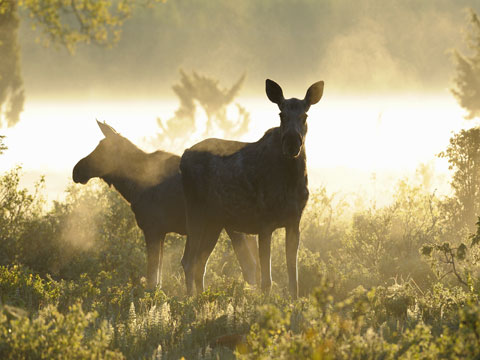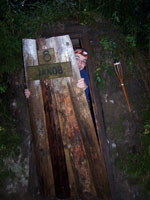Is it an elk? Is it a moose? If you’re in Sweden, the answer is “BOTH”! The iconic, majestic forest dweller Alces alces is known as a moose in North America (actually the sub-species Alces alces americana) and an elk in Europe. The word elk, like the Swedish word älg (pronounced /elj/), is taken from the Latin alces. To make matters even more confusing, elk in North America is used for an entirely different animal – a kind of deer, Cervus elaphus, otherwise known as a Wapiti, which looks like this.
The European elk (or moose), on the other hand, looks like this:

Photo: Lola Akinmade/imagebank.sweden.se
Elk are widely distributed throughout Sweden, from the giants inhabiting the wilderness of the mighty Sarek National Park in Lapland (hunting restrictions have meant that large bulls have been better able to survive and reproduce) down to the lower regions of this vast country, but the forests of Bergslagen are a particularly wonderful area for elk watching in Sweden. As home to the traditional royal hunting grounds, hunting pressure on the elk in this area is lower than in some other parts of Sweden, and as a result the elk population far outnumbers the human population! The area surrounding our log cabin holidays in Varmland also have high moose populations and offer very good chances to see elk in Sweden.

Photo:(showing Sarek moose): Staffan Widstrand/imagebank.sweden.se
Elk may be fairly common and widespread in Sweden, but that doesn’t mean they are easy to see, especially at close range. Elk are shy creatures, and will retreat into the cover of the deep forest at the slightest disturbance, loping off with a slow-motion gait that uncannily resembles a giraffe running on the savannah. While it is not unusual for a commuter returning from a day’s work in Stockholm to see an elk standing motionless on the edge of a field in the setting sun, similarly a hunter may wait a week in a hide in the woods and not see a single elk!

Photo: Folio/imagebank.sweden.se
During a recent visit to Sweden, the Nature Travels team had the opportunity to take part in an evening elk safari with local elk expert Marcus, who has been running elk safaris in the Bergslagen area for a number of years now and has never once returned home without a sighting. Hundreds of nights spent patrolling the forests, hills and dirt tracks of Bergslagen have given him an in-depth knowledge of the best places to find these beautiful animals, and all elk safaris now come with an “elk guarantee” – though Marcus says he still worries that one night they might all be hiding!

Photo: Håkan Vargas/imagebank.sweden.se
Due to time pressure we took the “express” version of the elk safari – a whistle-stop tour of some of the best local elk-watching spots – but nevertheless managed to see 9 elk in just over 30 minutes, including some wonderful close-up views of mother and calf and a large male with full antlers. The full safari takes a number of hours, and combines an exploration of the local forests on foot with observation from the minibus (as in Africa, vehicles can sometimes be less threatening to wild animals than a human presence on foot). Typically in recent tours it has been possible recently to see at least 30 animals in one evening, including some very close encounters indeed. The trick to getting close, says Marcus, is to crouch down in the grass until the elk bends its head to graze, then creep slowly forward. As the animal looks up, crouch down again and remain still, then creep forward again as it returns to graze. After a few minutes of patience and quiet, you can get closer than you would believe possible!

Photo: Eddie Granlund/imagebank.sweden.se
Elk safaris are available between May and September and include an atmospheric night in an authentic charcoaler hut!

As well as being home to thousands of elk, two of Sweden’s most exciting, most threatened, and most controversial predators roam the vast forests of Bergslagen – the wolf and the lynx. Reconciling the interests and opinions of conservationists, farmers, hunters, local people and politicians is never an easy task, and the presence of large predators in Sweden has always been a sensitive issue. But Sweden is tackling this question with typical foresight, compassion and practical skill. The research station at Grimsö, deep in the Bergslagen forests, works with radio tracking on local predator populations in an attempt to learn more about their movements and behaviour and develop management plans for their conservation and future survival, while at the same time working hard to maintain the trust and goodwill of those who may feel less than positive about the presence of wolves and lynx in the area. A recent initiative has been the introduction of special fencing, similar to an electric fence but with strands much closer to the ground, which has proved extremely effective in reducing livestock deaths due to lynx and wolves.
Having grown from just two individuals, the Swedish wolf population is in something of a genetic crisis. It is estimated that to keep the population genetically viable, new blood needs to be introduced at least every 15 years or so. Recently, there was great excitement when a new wolf appeared in the Dalarna area. Analysis of dung has identified this wolf as being part of the Finnish-Russian population, and it represents the first new blood for the local wolf population since the 1980s. Worryingly, there has been some conflict between this animal and local livestock populations, and its future remains uncertain, but with luck the animal may be able to breed with local wolves and provide a much-needed boost to the gene pool of the Swedish wolf population.
Since 2006, Marcus has been working together with the researchers at Grimsö to offer evenings of wolf tracking and wolf howling. To find out more about this spine-tingling adventure, see our Howling with Wolves experience.
Bergslagen is a fascinating area for wildlife watching, and the images of elk frozen in the torchlight are still fresh in our memories – we’ll make sure we plan a little more time for elk watching on our next visit!
Best regards
The Nature Travels Team
The Rovdjursföreningen (The Predator Society) in Sweden works for the interests of all large predators in Sweden: the brown bear, the wolf, the lynx, the wolverine, and, of course, humans, with a very informative website that is unfortunately only currently available in Swedish. However, for non-Swedish speakers they also have a wonderful collection of images – see https://www.de5stora.com/bilder-filmer/rovdjursbilder/ and click on the different “Våra bästa..” sections.
